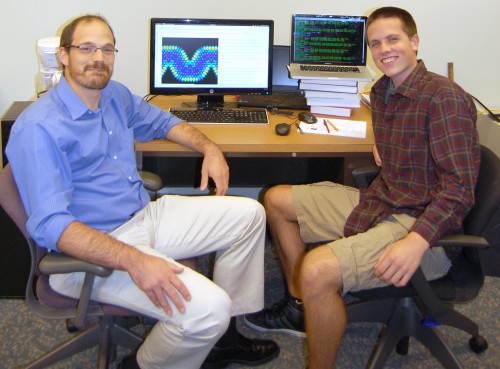 PROFESSOR VINCENT MEUNIER (LEFT) AND TYLER CARY ’13 (RIGHT) DISPLAY an image from the computational research they have done regarding graphene.
PROFESSOR VINCENT MEUNIER (LEFT) AND TYLER CARY ’13 (RIGHT) DISPLAY an image from the computational research they have done regarding graphene.Rensselaer’s Innovative Computational Materials Physics, headed by Professor Vincent Meunier, has been researching graphene for several years. Now, though, Tyler Cary ’13 is researching the electronic transport properties of 3TGNWs, three graphene “nanowiggles” which connect at a junction.
Graphene is a material made up of a single layer of carbon atoms. These atoms are bonded in a crystal lattice shape, similar to a honeycomb. Meunier coined the term graphene “nanowiggle,” or GNW, referring to a structure discovered by a team in 2010, which was published in Nature Physics in a paper titled “Atomically Precise Bottom-up Fabrication of Graphene Nanoribbons.”
A focus on graphene as an important and practical material in physics began in 2004. That year, Andre Geim and Konstantin Novoselov from the University of Manchester managed to isolate graphene in a laboratory setting by removing a layer of it with Scotch Tape from a block of graphite, in a process known as “micromechanical cleavage.” Graphene, which had to this point only been isolated using sophisticated chemical processes, was now economically viable to produce. Geim and Novoselov were awarded the Nobel Prize in Physics in 2010 for discovering this process. Since then, graphene has been heavily researched as a material for future use in multiple fields.
Once GNWs were discovered, computational research of their structure began by the ICMP group and Meunier. In 2011, the team published a paper entitled “Emergence of Atypical Properties in Assembled Graphene Nanoribbons.” Cary explained that “the group demonstrated that GNWs, which are essentially ‘wiggly rectangles’ cut out of a graphene sheet, can be designed and tuned to
have a variety of properties that may prove to be important for nano-electronic applications.” According to Cary, this tunable gap is hugely important, as pure graphene lacks this tunable gap. Graphene’s lack of a tunable gap has limited research due to the fact that its applications outside of theory are severely limited, particularly in the realm of electronics. With a gap, electronics and graphene’s interaction with electricity can be studied and, potentially, controlled.
Cary’s research is specifically in relation to 3TGNWs. He has been attempting to determine the conductance of these structures and density states. The hope is that 3TGNWs can eventually be used in transistors or other multi-terminal devices because of their extensive use in computing and most modern electronics. The purpose of Cary’s research is that “gaining an understanding of the electronic transport properties of 3TGNWs may help to reveal whether they could have nano-electronic applications in the future.” Cary said that, so far, the results are positive. The structures, apparently, have multiple tunable properties which may be exploited in the near future. Altering edge structures and length-to-width ratios directly affects the density of states and conductance of the 3TGNWs.
Cary is continuing his research on the subject, hoping to confirm his results to the point that they cannot be contested by other researchers in his field. At that point, Cary expects to publish a paper on his work. He hopes to do so within the next few months. For more information about Cary’s research, or any research being conducted by ICMP, contact Meunier at meuniv@rpi.edu.
